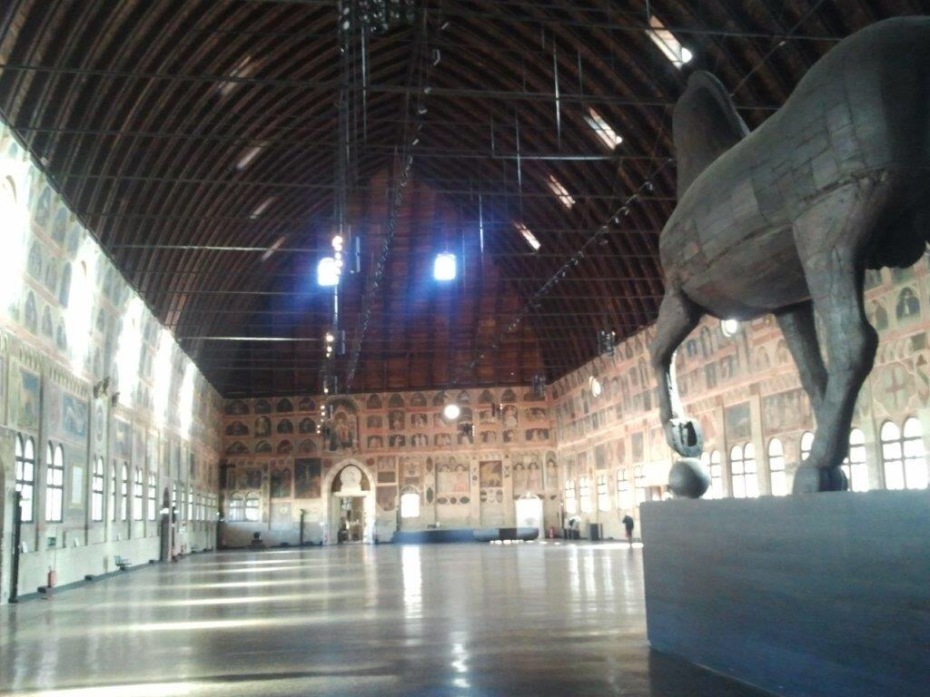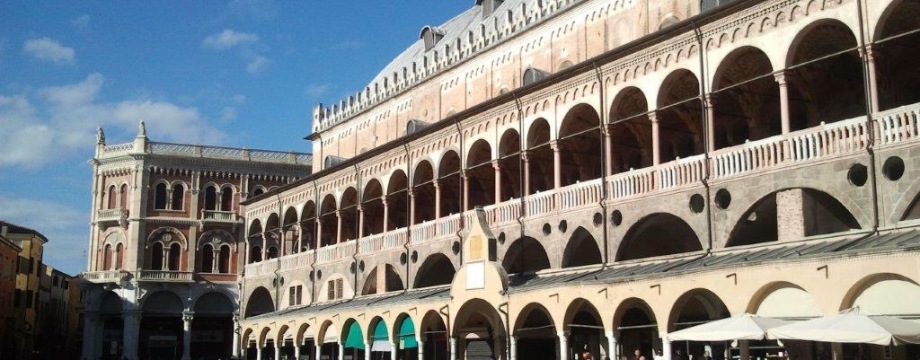One can get a glimpse of the former splendor of the Free Trade Center of Padua in northern Italy by strolling through Piazza dell’Erbe or Piazza della Frutta on a Saturday or in the morning during the week. Every day there is a bustling market and merchants praise their goods and delicacies. Between the two squares rises the Palazzo della Ragione. This former courthouse was built at the beginning of the 13th century. It dominates with its size the center of the old town of Padua.

Palazzo della Ragione
Even more impressive is the football field-sized and about 25 meter high council room (il Salone) inside the Palazzo della Ragione. This architectural masterpiece from the late Middle Ages is reminiscent of an inverted ship’s hull and is probably unique in its kind. Frescoes with religious and astronomical images adorn the huge unsupported wooden ceiling. Also to be visited in this magnificent hall is the “stone of shame”, a medieval pillory for defaulting payer and debtor as well as the gigantic wooden horse from the 15th century. Enjoy Padua and the Palazzo della Ragione! There is however, much more to discover in this beautiful town 🙂

Palazzo della Ragione (il salone)
Man kann sich vom ehemaligen Glanz der freien Handelsstatt Padua in Oberitalien ein Bild machen, wenn man an einem Samstag oder vormittags unter der Woche über die Piazza dell’Erbe oder Piazza della Frutta schlendert. Täglich herrscht dort ein emsiges Markttreiben und Kaufleute Preisen ihre Waren und Köstlichkeiten an. Zwischen den beiden Plätzen erhebt sich der Palazzo della Ragione. Dieses ehemalige Gerichtsgebäude wurde zu Beginn des 13. Jahrhunderts erbaut. Es dominiert mit seiner Grösse das Zentrum der Altstadt von Padua. Noch beeindruckender ist der fussballfeldgrosse und ca. 25 Meter hohe Ratssaal (il Salone) im Innern des Palazzo della Ragione. Dieses architektonische Meisterwerk aus dem ausgehenden Mittelalter erinnert an einen umgekehrten Schiffsrumpf und ist wahrscheinlich einmalig in seiner Art. Fresken mit religiösen und astronomischen Bildern zieren die riesige stützenlose Holzdecke. Ebenfalls zu besichtigen in diesem prächtigen Saal ist der „Stein der Schande“, ein mittelalterlicher Pranger für säumige Zahler und Schuldner sowie das gigantische Holzpferd aus dem 15. Jahrhundert. Viel Vergnügen in Padua und im Palazzo della Ragione!…es gibt noch viel mehr zu sehen in dieser schönen Stadt 🙂

When I was back home, I used to go to Padua every weekend…our home is at 20 minutes from Padua…I loved enjoying a spritz or Prosecco in Piazza delle erbe…😉😊
LikeLiked by 2 people
Ohhhh just got on wordpress and realised that we can’t talk and make friends thought it was like a social site stupid me…. I really would love to talk to you your travel posts are so nice 😅
LikeLiked by 2 people
Dear Sharon, I am just about to leave for Russia where I will stay until the end of this month. There, I will have limited WiFi and little time to be online. Therefore, I switched my Blog on „autopilot“, i.e. the upcoming posts will be automatically posted until I am back. Thereafter, you may contact me! Cheers, Roland
LikeLiked by 1 person
“The hall of audience in the town-house, properly designated by the augmentative Salone, is such a huge enclosure, that one cannot conceive it, much less recall it to one’s immediate memory. It is three hundred feet long, one hundred feet broad, and one hundred feet high, measured up to the roof, which covers it quite in. So accustomed are these people to live in the open air, that the architects look out for a market-place to overarch. And there is no question that this huge vaulted space produces quite a peculiar effect. It is an enclosed infinity, which has more analogy to man’s habits and feelings than the starry heavens. The latter takes us out of ourselves; the former insensibly brings us back to ourselves…” (Goethe, 1786)
LikeLiked by 1 person